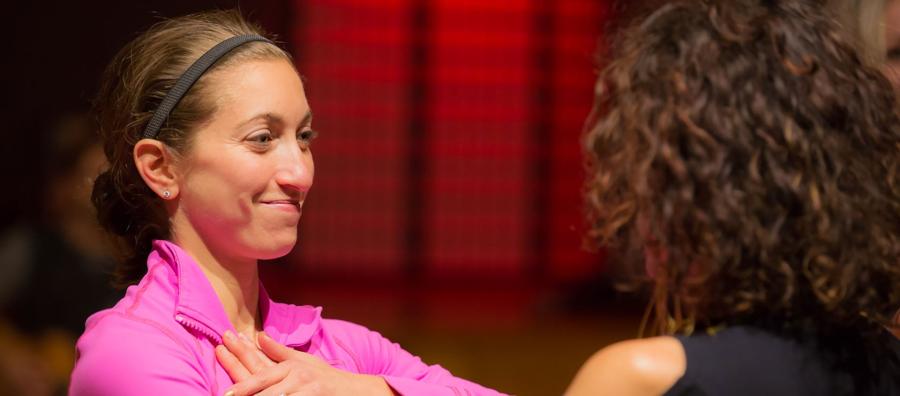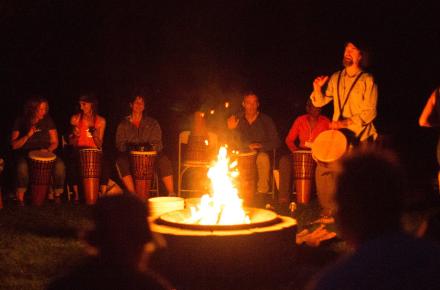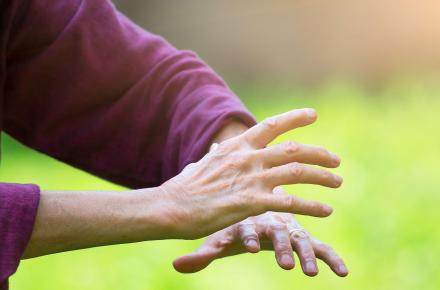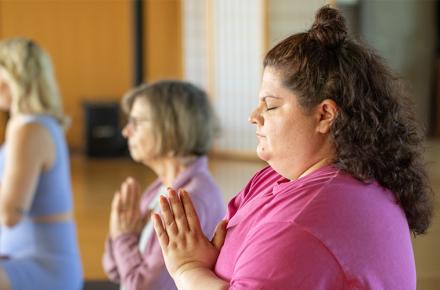Waking Up Together: The Power of Insight Dialogue

Florence Meleo-Meyer, MS, MA, has been teaching meditation for more than 35 years. She’s also a senior teacher of Insight Dialogue, an approach to meditation that is practiced with another person and includes both silence and sharing. We asked Florence to explain the Insight Dialogue practice, and how it benefits us “off the cushion.”
What is Insight Dialogue (ID)?
It’s an interpersonal meditation practice that involves speaking, listening, and pausing into present-moment awareness. The intention is to deepen and extend our capacity to remain centered and awake during moments of mutual contact. ID practice offers guidance to strengthen the potential to “wake up together.” Our dependence on communicating electronically can give us the illusion of connection—engaging with another as a meditation partner, in the mutual support of insight, is an opportunity we don’t often have. This practice can offer dimensionality and depth, even if you’ve had a solo meditation practice for a long time, or have been on several meditation retreats.
We’re social beings—we actually have to be seen by others to survive. But relationships and social connection are often a place of great tenderness for many of us, and that can express itself in the longing to be seen, heard, and recognized, or the need to hide at times. To actually engage with another person in meditation can be remarkably freeing and have great potential for one’s daily life.
Insight Dialogue is not a communication workshop—it’s not teaching language techniques or communication patterns. This is more a direct experience of being embodied in one’s own life and then connecting with another human being from a place of being centered and quiet. The conditions are cultivated to support greater freedom and insight. It’s a practice that is so needed in our current world environment, and it also supports each of us in caring for ourselves with facing the challenges that are upon us right now.
Could you explain what people actually experience when doing the practice?
You’re sitting, face-to-face with another person, and you’re guided into a particular contemplation related to a core human experience, such as aging, change, judgments, roles. You’re given the space and the support to connect with yourself and then speak from that place of authenticity, to be heard and received, and to listen deeply to the other person.
Our habitual communication patterns tend to come up, like the tendency to want to give advice, to withdraw, or to be clever, and these habits can be directly experienced without acting on them. This is the benefit of the pause and other ID meditation guidelines. Instead, you’re holding that space for yourselves and each other, feeling it in the body. The power of being “listened into presence” in itself is extraordinary. You’re strengthening your capacity to be fully awake, present and open, while engaged with another human being.
Sometimes people come with loved ones or partners, but we really want people, as much as possible, to practice with people they don’t know so much. The reason for that is that we have less patterned expectations and assumptions with people we don’t know, and so it allows more discovery in the moment. It’s transferable to two people who know each other, of course, but the goal is not to work out relational problems. While this may be a potential benefit, it’s really more about waking up, and having both the challenge and the support of good company in that process. This brings together both the inward-looking practice and the practice of listening to another.
What inspired Gregory Kramer [founder of Insight Dialogue] to create this practice, and what traditions and teaching did he draw from?
Gregory is a Vipassana teacher who, over years, went on several extended silent retreats, and found that it could be challenging to maintain compassionate awareness when he was back with his wife and family. Reflecting on the separation of retreat time and time with the family, he explored relational meditation practice as a way to include his whole life—whether he was alone, on retreat, or with others.
In creating Insight Dialogue, he drew from contemplative practice, from Buddhist and wisdom traditions. Wisdom, relationship, and meditation are the essential foundations of Insight Dialogue. The way that they can synergistically augment one another is the fruit of the practice. There are six guidelines for Insight Meditation: pause, relax, open, trust emergence, listen deeply, and speak the truth.
What are the benefits of Insight Dialogue that we can take into our daily lives?
We tend to suffer a lot in terms of relationships and interaction with others—there’s a whole range of social stress we experience, from shyness to social anxiety. Being with another person in this way can help undo that. It can affect us even in the simplest, briefest moments of contact—in the grocery store, at the gas station. What is it like to actually meet yourself and another, to be present within these momentary exchanges with another?
It can also help move you past stuck places in lifelong relationships. I’m thinking of an older woman who took this course, and had had a contentious relationship with her adult son for years. He was coming to visit, and she talked about how, in the past, they would always get caught in an argument and leave unhappy. This time, after taking the course, she said to him when he visited, “I’d like to talk with you using some guidelines I’m learning.” He was willing, so they structured their conversation with the Insight Dialogue meditation guidelines and, afterward, he said, “I feel like this was the first time you actually ever listened to me.” And she told him, “I feel like this was the first time I could say what was actually true for me.” Their relationship shifted in a major way. They now have this practice to use as a support to keep nurturing greater freedom and love in this mother-son relationship.
It’s a time in our world where we need to have difficult conversations, and we need to find internal and mutual supports that help us listen to other points of view that may be hard for us to hear. This could be an avenue to begin to do that. It’s a meditation practice that’s more than improving communication patterns. It’s about establishing presence and waking up together to the fact that all lives have suffering, that there is constant change, and that this sense of “me” that we sometimes surround with rigid boundaries actually has more fluidity to it than we often allow ourselves to experience. We get the chance in a retreat setting to strengthen those muscles, and then we take it on the road, we take it into our lives.
As much as we often crave intimate connection with others, we also shy away from it. What would you tell someone who was interested in learning this approach, but was uncomfortable about how much they would have to share about themselves, or nervous about being in an intimate dialogue with someone they don’t know?
That would be totally natural. My approach is to normalize that feeling of discomfort or shyness, and to guide people in pausing and looking at where they might be feeling that in the body. Recognizing and experiencing those feelings is part of the practice. In terms of speaking, the contemplations that I offer invite people to reveal what feels appropriate, and to know that what and how much they disclose is their choice. We also have a very strong commitment to maintaining confidentiality, to honor what is revealed and shared.
As human beings, we are pulled and, at times, driven by interpersonal desires to avoid loneliness and seek social pleasure, to gain attention and be seen, to know we are valued, and also to hide, to pull away and not be seen. I sometimes share an experience I had where I was entering a social situation, and casually stood behind a chair. Pausing, I became aware that I was feeling shy and wanted to pull away from engaging with others. Once I knew that, I was free to shift the way I was relating to the moment and with others. One young woman, hearing this story, took the mic and said, “I don’t really have anything to say, I just need to step away from the chair.” She was inspired to be seen, to be heard. She could make that choice in that moment and voice it, and that was really profound for her. It sounds like a small change, but I trust small changes a lot.
What brought you to this work?
I have always had a longing to explore the potential and depth of what this is to be human, to be alive. Meditation has offered me an amazing adventure of exploring greater and greater dimensions of that, and yet, even after years of practicing, I would find there were still places where I struggled in relationships. There were times when I felt a kind of pulling back or wanting to be seen more, to be heard more—very old stuff. When I experienced Insight Dialogue, I realized, oh, you can actually take this to the cushion, so to speak. The relational can be a part of meditation practice and a path of awakening, and it has been that for me.
It’s not alone or together, it’s really alone and together—the practice cultivates the space for coming home to yourself while you’re engaged with another person. And you have the support of another person who’s bringing intentionality to being awake in the moment so, if you’re lost, you can lean in to your partner’s presence.
If you were to offer one simple recommendation to help people get started in a meditation practice, what would it be?
The key to either a solo or a mutual practice is the first guideline of Insight Meditation, which is pause. It’s the choice to be awake in the moment, to recognize that the only moment we’ve got is now. We can do that alone and it could be with another. Whether you’re feeling tightness in chest, openness in chest, ease or contraction, it almost doesn’t matter—it’s the knowing it, the pause and the choice to wake up from the locomotive-like forward rush of our conditioned lives. Sometimes it feels like practicing has to be a big project, but it might be just one breath. It’s just being right here, right now.
Find out about upcoming programs with Florence Meleo-Myer.
© Kripalu Center for Yoga & Health. All rights reserved. To request permission to reprint, please e-mail editor@kripalu.org.


















































